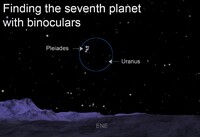Week of November 16-22, 2025
Nearly two and a half centuries ago, in December of 1781, musical composer and amateur astronomer William Herschel was scanning his telescope through the skies over England when he came upon a tiny bluish-green dot that did not appear on his star charts.
He soon realized it wasn't a star but rather a planet — the first ever to be discovered. To cajole some money out of King George III, he suggested naming the new world in his honor: Georgium Sidus ("George's Star"). Saner heads prevailed, however, and astronomers agreed that the new planet's name should match the classical origins of other planetary names. They decided to name it after Ouranos (OOH-rah-nohs), the mythological father of the Titans and grandfather of Jupiter. And so it was named Uranus.
Today, Uranus is, without a doubt, the most mispronounced planet in the English language, always getting a giggle out of kids (and even adults). Of course, you can say it any way you'd like, but if you'd like not to appear foolish, use its correct pronunciation: YOU-rah-nuhs.
On Friday, Nov. 21, Uranus will officially lie at opposition — the point in the sky where it appears opposite the sun. This distant world is typically visible only with binoculars or a small telescope, but at these times it enters the realm of naked-eye visibility for stargazers with excellent vision and a clear, dark sky far from city lights. This week will be a great time to search for this elusive planet.
In addition to needing good vision and a dark sky, finding Uranus requires some patience, but it's as difficult as you might imagine. Right now, you can find it roughly in the direction of the Pleiades, or Seven Sisters, a tiny cluster of stars low in the eastern sky after dark. To find it, aim binoculars toward the Pleiades, and place the cluster on the upper left side of the field of view. Uranus will appear on the lower right.
It will look like a star but may appear slightly brighter than the faint stars around it, and it may show a subtle blue-green tint. Use the pattern of stars in the accompanying illustration to identify Uranus among the stars.
Once you've found it and can identify the stars around it, put the binoculars down and try searching for it with your eyes alone. If you've got a very dark sky and good vision, you may be surprised by how easy is! If you spot it, you may wonder why ancient skywatchers hadn't found it millennia ago.
While it's true that these stargazers had no binoculars to help them along, they did have extremely dark skies with no city lights. And many were meticulous and obsessive about their celestial observations — especially the ancient Chinese.
Why they failed to find this planet among the starry sky is anyone's guess. Perhaps someone did spot it but never recorded the discovery. Perhaps their records have been lost over time.
In any case, this week's a great time for modern stargazers to do what the ancients never did ... track down and observe this elusive and distant planet in our nighttime sky.

Visit Dennis Mammana at dennismammana.com. To read features by other Creators Syndicate writers and cartoonists, visit the Creators Syndicate website at www.creators.com.
On Friday, Nov. 21, Uranus will lie at opposition — directly opposite the sun — making it visible in a clear night sky.






View Comments